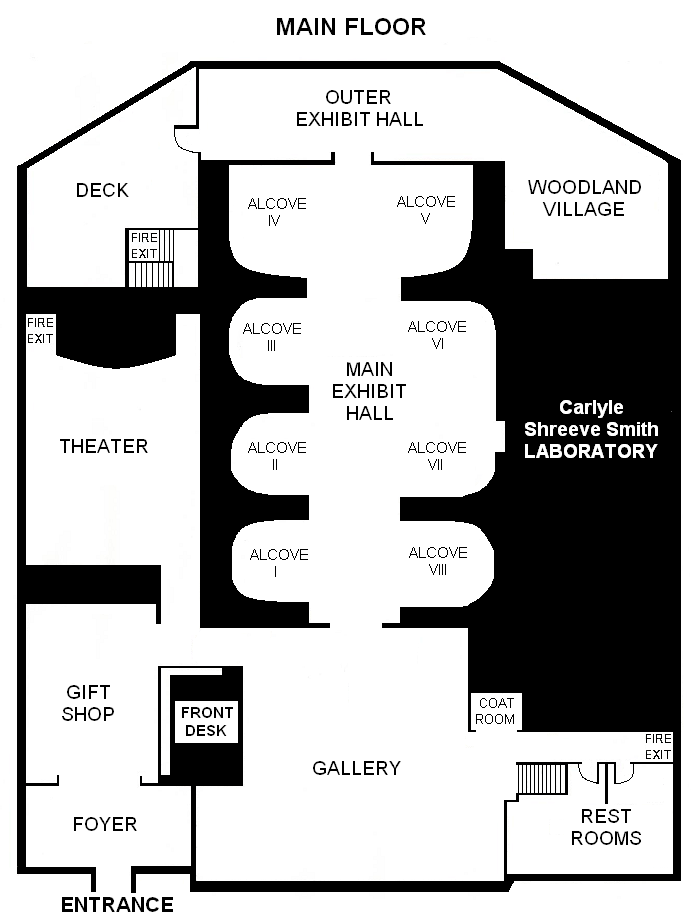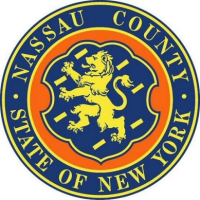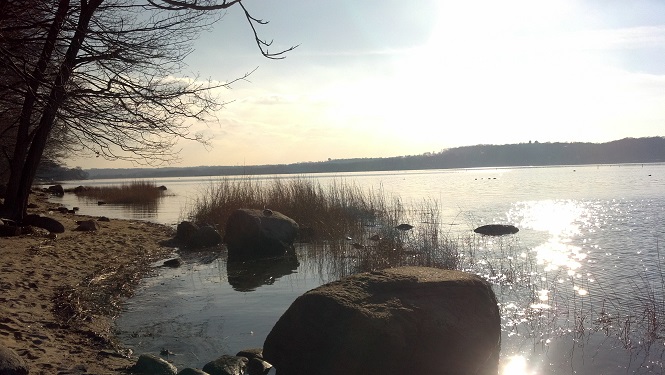The Exhibits of The Museum

This is a bird's eye view of the main floor
The museum's exhibits offer Long Island and New York State geology and Long Island Native American culture and archaeology.
Geology exhibits illustrate Long Island's glacial history and explain the formation of today's land features. Dramatic post-glacial changes in climate
and sea level are detailed in dioramas to show the evolution of our landscape during the past 20,000 years. Local leaf fossils and concretions ("Indian paint
pots") are also on display.
There are several more recent exhibits, including a major addition to the permanent exhibits, "The Seasonal Round", an attractive new diorama exploring Long Island Native American lifeways
throughout the seasons of the year. Some of the latest archaeological theories are also detailed in a nearby audio exhibit. Our most recent exhibit is an Interactive Woodland Village, where children and adults are welcome to "plant" corns, beans, and squash or "fish" from the Dugout Canoe.
The archaeological exhibits begin with the migration of peoples from Asia to the New World, and his subsequent cultural evolution. A series of exquisite
dioramas illustrates Indian life scenes from Long Island. Numerous prehistoric Indian artifacts are displayed. Other exhibits deal with the first European
contact, in the ultimate demise of the Native American culture. The science of archaeology is the subject of several exhibits, including a model of the archaeological
excavation.
FOYER
Admissions / The Garvie Family Tree / Announcements
GIFT SHOP
Giftware & book Sales / Front Desk Information
THEATER
Films / Presentations / Programs / Talks
GALLERY
GEOLOGY AND FOSSILS OF NEW YORK STATE
Geologic Timeline... Precambrian-Present-50 million years from now
How Fossils are Formed
Late Cretaceous Plant Fossils of Garvies Point
ROCK PORTRAITS... The Abstract Art of Minerals Through the Microscope
HOW CRYSTALS FORM: Crystals... Flowers of the Lithosphere
A Study in Nature, Philosophy, Art, Science and the Cycles of Nature
Zodiac Birthstones
Gemstone of the Month
GEOLOGY, FOSSILS, GEMS, MINERALS
MAIN EXHIBIT HALL
Center Aisle:
The Present is the Key to the Past
SEASHELLS... NATURE'S INSPIRED DESIGN
Window I: Geology of Garvies Point, Ventifacts & Loess
Alcove I:
Rock Cycles
The Rattle Stone Story & Concretions of Garvies Point
GELOGY & THE ORIGIN OF LONG ISLAND
Geomorphology - study of landforms
Climate Change
Window II: Peoples of the North, Artifacts of Arctic Peoples
Alcove II:
PEOPLES OF NORTH AMERICA
Prehistoric Native American Cultures
Native American Life Ways in Early Historical Times
Windows III - V: Archaeology of Long Island, Wolver Hollow House
Alcove III:
PALEO-INDIANS OF THE NORTHEAST
PREHISTORIC INDIANS OF LONG ISLAND
Woodland Stage Artifacts
Pottery of the Northeast
Alcove IV:
East Coast Algonkian Indian Tribes in the 17th Century
Native Long Island Life Ways Through the Seasons
Prehistoric Settlements: Practice of Seasonal Round
Freestanding - Archaeological Excavation Diorama
Alcove V:
Animal Pelts
Native American Tool Technology
LONG ISLAND INDIAN VILLAGE - at European contact
Native Americans and the Environment
Alcove VI:
Replica of an Archaeological Excavation or "Dig"
Life Scene at an Indian Campsite, 1300 AD, Glen Cove Creek
Alcove VII:
Projectile Point Types of the Northeast
Animal Bones & Shell... What They Tell Us
Wigwam - original construction by the late Cree Elder Don Cardinal, later restored by Teepee Ted
Window VI: Geology of Long Island, Glacial Drift of Long Island
Alcove VIII:
Long Island's Changing Post-Glacial Landscape
The Past 20,000 Years & The Environment's Impact on Culture
Palynology - age determination by pollen and spore studies
Ironstones & Puddingstones of Garvies Point
Window VII: Geology of Garvies Point, Cretaceous Clays
OUTER EXHIBIT HALL:
Interactive Woodland Village
The First People of Long Island...
Eastern Woodland Period (1000 BCE - 1600s)
Dugout Canoe and Wigwam
Massapequa Lake Blade Cache
INNER DECK & OUTSIDE COVERED DECK
Activities / Lunch Area / Preserve viewpoint

